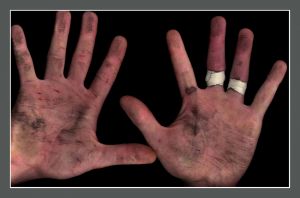
Getting Your Hands Dirty in Medical Device Design
Many of us understand the benefits provided by workflow investigation, procedural observation, literature searches, and contextual research – and another piece of the product development puzzle is hands on exploration. This often requires getting your hands bloody, slimy, or sometimes worse.
There are a few avenues to explore – but, when appropriate, my favorite is the ex-vivo porcine model given the following benefits:
- Porcine model has many similarities to internal human anatomy
- A local butcher or slaughter house can provide the necessary anatomical feature quickly
- Minimal or no cost
- Little or no ethical and regulatory barriers
Although many of the people at StarFish Medical have a bio-medical background, we are typically not as familiar as the surgeons/practitioners that may commonly use the device we are developing. Understanding the constraints associated with product development process, for example, puncturing, sawing or drilling through a bone for an intraosseous device, is best done on a real bone. If a practitioner familiar with the procedure is available to work cooperatively with the engineer, the benefits multiply.
Alternatives such as human cadaver, non-invasive human in-vivo, in-vivo animal, ISO 10993 biocompatibility testing, formal verification/validation testing as well as a host of other tests all have their place in the product development process. In selecting the appropriate model, it is important to consider the applicability of the model to the device, the level of maturity of a prototype, and time and budget constraints.
One recent example of utilizing a porcine model involved our investigation of a section of the gastrointestinal tract. First we studied if any of the differences between a porcine model and a human would impact our results, or at the very least, understand that these differences exist. Despite the longer, spiraling colon, enlarged pyloric region and a few other differences, we were mostly satisfied that it would be suitable for early stage work. A local slaughter house provided us with a large bag of entrails – and we had more than we bargained for. By using these entrails, we were able to collect surrogate data on a prototype for form, fit and functionality. The results gave us a strong indication that we were on the right development path, and de-risked the financial and ethical obligations associated with subsequent and more formal trials.
Some of the disadvantages of working with an ex-vivo porcine model include:
- Subtle differences in physiology may lead to erroneous results
- Ex-vivo results can differ in various mechanical properties, such elastic modulus, tensile strength, coefficient of frictions, temperature effects, and a host of others
- Fixturing or positioning of a specific anatomical feature may not be representative of in-vivo use
Despite differences when transitioning to humans, the porcine model is an excellent way to test early protototypes or design iterations quickly and easily.
Mark Drlik is the Director of Program Design in Business Development at StarFish Medical. With over 20 years of product development experience, he works with clients to transition medical devices from initial product architecture definition to final product delivery to ensure client success.
Image: freeimages.com